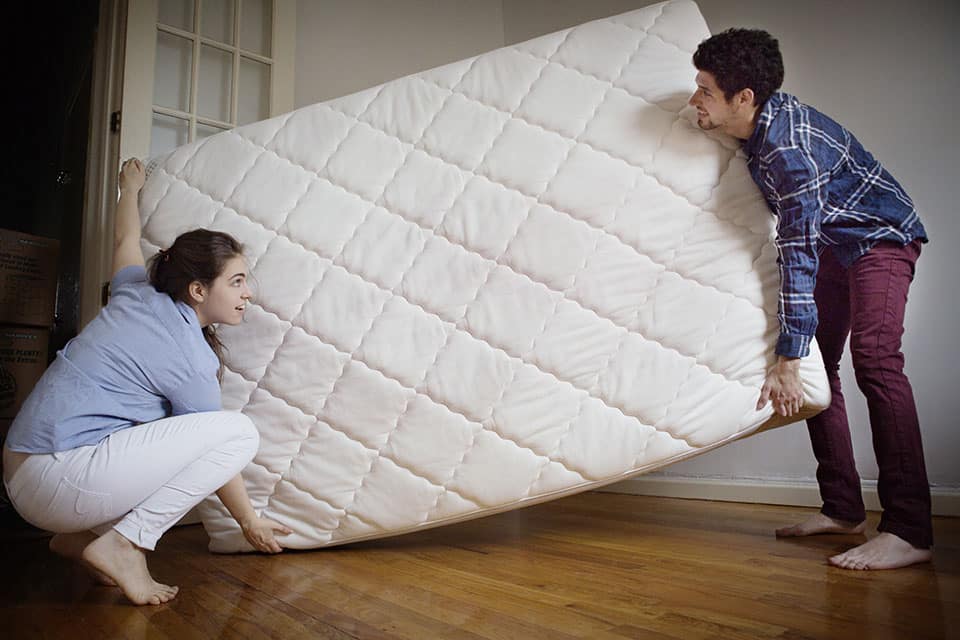
New year, new home? If you fall into this category, congratulations! Whether your move is for upsizing or downsizing, it’s a great opportunity to assess your home inventory and decide what items to take or leave. This is an easy decision for smaller items that aren’t considered “essentials”. However, larger household staples may take more consideration, like your mattress.
To move, or not to move?
Should you take your mattress to your new home? Or is it better to buy a new mattress rather than take it with you? Honestly, unless your mattress is ready for retirement, there’s no right or wrong answer here. If it’s time to replace your old, tired mattress, then having a replacement delivered to your new address takes the moving burden out of your hands.
However, if buying a new mattress in the middle of a move isn’t convenient, necessary, or affordable, then mattress moving probably just landed at the top of your moving to-do list, and today’s blog post will help ease the burden of this task with helpful tips on how to move a mattress.
Where do I start?
Mattresses are bulky, which makes moving them a real challenge. However, they are also where you sleep, so keeping them clean during transport should be a top priority. An unprotected mattress can pick up a lot of ick during a move, from dust to dirt to bugs. So, we recommend always wrapping a mattress when moving. It will ensure your no.1 sleep essential will stay fresh and clean in transport to its new home.
Fortunately, buying a mattress bag for moving is easy to do and affordable. Whether you buy one online or at a store, a mattress cover will run you anywhere from $8 to $40, depending on the size and quality of the cover. Getting the cover on the mattress may take a helping hand, but it can be a manageable solo project with some planning and patience.
Pro tip: if you want to clean your mattress before wrapping it, then strip the mattress and let it air out before vacuuming the entire surface clean. Once cleaned, the mattress is ready for wrapping.
How to move a mattress by yourself.
Now that you have your mattress wrapped and ready, the real work begins. If you can pass it along to a moving team for loading and unloading, that’s a bonus. However, many of us make moves without hired help, so figuring out how to move the larger household items, like mattresses, can be tricky.
Begin by mapping a route and clearing a path to maneuver the mattress from its resting place to the car or truck. If you do not have a dolly or friend to help with this, grab a cardboard box or two and lay them flat on the floor. Next, slide the mattress on top of the flattened boxes. The cardboard boxes will help bulky mattresses “glide” across carpeted and hard floor surfaces with relative ease.
Here are some tips for making solo mattress moving easier:
- Reinforce floppy mattresses with cardboard in the front and back (over the mattress cover) and secure them with steps or duct tape.
- Turn the mattress upright on its longer side for easier sliding and transport through doorways.
- On stairs, turn the mattress on its side to align it with the wall or stair rail and slowly allow gravity to help move it downstairs.
- Bend knees and hips and lift from your core when you need to lift the mattress, such as over curbs or into the moving truck or van.
- Keep the mattress close to your body and below shoulder height during transport.
- Take breaks when needed by leaning the mattress against a wall while you rest.
Car transport? Use caution.
Once the mattress is wrapped and carefully moved outside, it’s time to load it up. However, if a truck or van large enough to hold the mattress are not an option, then a car’s roof might work depending on both the size of the car and mattress involved. Wondering how to attach a mattress to the roof of a car? We recommend only doing so with extreme caution and as a last resort.
Correctly tying a mattress to your car for transport is not illegal. In most states, it sort of falls in a legal gray area even if there isn’t a law explicitly prohibiting it. However, tying a mattress improperly onto the roof of your car is 100 percent illegal, because you’re endangering not just your life, but also the life of other road users. So, although it can be done, it requires extreme care during packing and transporting, i.e., drive slowly and stick to side streets for safety’s sake.
If the car has a luggage rack, the job will be easier, as the mattress can be safely secured to the rack with industrial-strength rope or ratchet straps. However, in the absence of a luggage rack, the mattress should lay flat across the car’s roof. If you have a box spring, lay it on top of the mattress.
Begin by propping the mattress against the side or back of the car. Next, bend at the knees and lift and push the mattress from the bottom until it slides over the top of the car. Be sure your core is engaged throughout the work to protect your back.
Once in place, secure the mattress to the car’s roof by threading the rope or heavy-duty adjustable straps through the windows and over the top of the mattress, pulling them tight enough to securely hold the mattress’s bulk in place. If possible, use ropes or straps at the two ends and in the middle of the mattress to keep it from sliding around. Also, include a strap going from the front to the back of the car to secure the front so it does not catch air and flip up dangerously. It’s best to use as many straps as necessary to ensure the mattress is securely strapped on, as safety is critical at this stage of the game.
Pro tip: Do not thread rope or cord through the passenger or driver’s side windows. Doing so will prevent the door from opening, which is dangerous if you need to exit the car in an emergency.
How to move a memory foam mattress.
If your mattress is memory foam, you can fold it in half for easier transport. Curious about how to compress a memory foam mattress for moving? If you bought it new, it likely arrived rolled up and sealed in plastic – and getting it back into a similar state for moving is labor-intensive but not impossible.
To get there, we suggest watching this YouTube instructional video for step-by-step instructions. As the video instructs, you will need a mattress bag, tape, scissors, and a vacuum with a hose attachment (a shop vac works best) – and some help from another person.
Pro tip: When transporting your rolled memory foam mattress, keep it horizontal to prevent damage.
If DIY compression makes you nervous, then a memory foam mattress can be moved like any other mattress following the directions we gave earlier, i.e., a mattress bag for moving, a dolly or flat cardboard boxes, etc.
.
Mattress moving, especially if you are alone, can be cumbersome. It’s always best to enlist some help if you can. However, if you’re handling the mattress moving solo, hopefully, these tips will help make it less stressful and a little easier to accomplish. For more pro tips on mattress care and other sleep-related topics, visit www.bettersleep.org.



